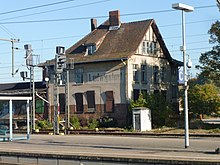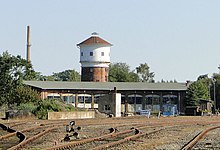Ludwigslust train station
| Ludwigslust | |
|---|---|
|
Reception building
|
|
| Data | |
| Location in the network | Separation station |
| Design | Through station |
| Platform tracks | 5 |
| abbreviation | WL |
| IBNR | 8010216 |
| Price range | 4th |
| Profile on Bahnhof.de | Ludwigslust |
| Architectural data | |
| Architectural style | Late classicism |
| location | |
| City / municipality | Ludwigslust |
| country | Mecklenburg-Western Pomerania |
| Country | Germany |
| Coordinates | 53 ° 20 '4 " N , 11 ° 29' 41" E |
| Railway lines | |
|
|
| Railway stations in Mecklenburg-Western Pomerania | |
The Ludwigslust train station in the Mecklenburg town of Ludwigslust was built with the construction of the Berlin – Hamburg line and opened in 1846. When the routes to Parchim , Holthusen and Malliss went into operation , it became a traffic junction. The station with reception building, platform, engine shed and water tower is a listed building.
location
Ludwigslust train station is located in the north of the built-up urban area on the 170.8 kilometer line of the Berlin – Hamburg line. From the city center, a two-lane cobblestone avenue running parallel to the Ludwigsluster Canal , the Bahnhofsstraße, leads to it. The road used to continue in the direction of Wöbbelin , but the level crossing on the southeast side of the station was closed when the line was expanded in 1996. Also on the south-east side, the Ludwigsluster Canal crosses under the railway tracks. A little further on are the buildings of the Bethlehem Abbey Hospital . There are bus stops on the station forecourt.
Investments
Reception building
Like almost all buildings of the Berlin-Hamburg Railway, the entrance building of the Ludwigslust train station was built in the late classicist style. The specifications for the construction probably come from Friedrich Neuhaus . In the initial state, the building initially had seven axes in the longitudinal direction and five axes in the transverse direction. There is a mezzanine above the two floors . The building is covered by a flat hipped roof . In the original state , the architectural design elements included corner projections , cautiously used ornaments and the light plaster color. On the track side, the windows on the upper floor between the risalits are built higher than on the other sides. There are pilasters between them . The mezzanine floor has no separate windows there.
The construction and commissioning of further railway lines also made it necessary to expand the reception building. The right side of the building, seen from the street, was added. Since it is kept in the same style, you can only see the extension of the building on closer inspection. The newly created corner projection is wider than the left corner projection and the current central projection. With only three transverse axes, the extension is also narrower than the rest of the building. The roofing of the house platform has a wall connection. Within the building, new rooms were allocated to individual departments during the renovation, so the post came to the previous telegraph room, and the first and second class waiting room, which was now in the new half of the house, became the telegraph room and baggage handling. On the second floor there were apartments, an office and the messenger's room. The windows on the mezzanine floor were subsequently enlarged.
The single-storey extension on the north side, the so-called prince's room , contained a large room, a ladies' room, a washroom and an adjoining room and was intended for the ducal family who had their summer residence in Ludwigslust Palace .
Platforms
The station has a house platform and two central platforms and a total of five tracks. All platforms can be reached through a pedestrian underpass, which, starting on the south side of the station, also connects Bahnhofsstrasse with Wöbbeliner Strasse. The house platform can also be reached by leaving the reception building on the track side.
Other plants
To the northwest of the platforms are the remains of non-electrified shunting tracks. The building of the goods handling facility, built in 1912, and the round locomotive shed with turntable and water tower have been preserved. The unused drainage mountain can also be seen there . As of September 2011, trees were already growing in the track bed on it.
history
On July 27, 1843, the founding meeting of the Berlin-Hamburg Railway Company took place in Ludwigslust. Less than a year later, on May 6, 1844, the city began building the railway line between Berlin and Hamburg. The station was built near Kleinow / Klenow, which is now part of the Ludwigslust urban development. The line between Berlin and Boizenburg was opened on October 15, 1846. Exactly two months later, the remaining section to Hamburg followed. Initially there was only one train per day and direction; as early as May 1847 there were two pairs of passenger trains and one pair of freight trains.
The connection of the city of Schwerin to the Berlin-Hamburg railway line took place in 1850 initially only via the Hagenow Land station . Although Ludwigslust was still the summer residence of the Mecklenburg dukes at the time, there was a direct connection to Schwerin via Holthusen only from October 1, 1889. On June 15, 1880, the Ludwigslust – Parchim railway line , and on May 20, 1890, the Ludwigslust – Malliss railway line opened, the further section from Malliss to Dömitz had already been opened in 1889.
Until 1920, when the previous regional railways were placed under the sovereignty of the German Reich and merged into the Deutsche Reichsbahn , the Ludwigsluster Bahnhof was a joint station of the Prussian State Railways and the Grand Ducal Mecklenburg Friedrich-Franz Railway , which led to conflicts in the distribution of the costs for station extensions led. As early as 1898, the Schwerin railway administration wanted an additional central platform to ensure connections to Hamburg and Berlin. The need for extensions also became clear in 1899, when parts of freight trains had to be parked on the open route due to lack of space. Extensive expansions took place between 1909 and 1913. So soil was removed between Ludwigslust and Eldena , which was heaped up on the station grounds and laid on the tracks. A goods shed converted in 1890 to make room for new tracks was demolished in 1911 and replaced by a new building in 1912. The water tower and a new engine shed were also built in 1912. The new guard signal boxes Lw (north-west side) and Lo (south-east side) were built. The command signal box Lb to the west of platform 2 replaced the previous control rooms A to E.
On October 1, 1913, a connecting curve between the railway lines to Dömitz and Parchim with the signal boxes Lvn and Lvs was put into operation southeast of the station , on which freight trains passing through could bypass the station without paying fees. After there was no longer any reason for this connection under the Deutsche Reichsbahn, it was dismantled around 1925. For tactical reasons it was rebuilt by 1943. After the war, however, the track and the systems in the two signal boxes were removed again.
On February 22, 1945, an air raid took place with the aim of destroying the railway junction. This failed, however, in the station area, an apartment in the station building, the Lm signal box and the railway maintenance building, which was subsequently rebuilt, were damaged. In contrast, residential buildings in the vicinity of the train station were hit. The air attack cost the lives of around 150 people in Ludwigslust.
In 1957 the station received the central image signal box B 1 . On May 27, 1962, the Deutsche Post parcel transhipment point opened at the train station, through which, from May 31, 1964, all parcel shipments between the three northern districts of the GDR, Neubrandenburg , Rostock and Schwerin and the Federal Republic of Germany, were processed. The facility, which had its own sidings, was in operation until 1993, and the post office building at the station from 1913 was later closed. After 1980 the second track between Wittenberge and Schwerin was rebuilt.
In 1986/87 the section between Magdeburg and Schwerin and thus also the Ludwigslust station were electrified. After the political change , the line between Berlin and Hamburg was expanded until 1996/1997, and ICE has been using it since 1997 . Bombs from the Second World War were found during construction on March 26 and 28, 1996. The level crossing near the station was closed as part of the construction work in 1996, the platforms were renewed. The B1 signal box was shut down in the spring of 1998 and was demolished in July 2006. By 2003, the control of the railway traffic was carried out of the electronic signal box Hagenow land below from the operations center Berlin-Pankow. In a second stage of expansion, the Berlin – Hamburg line was expanded in 2004 to speeds of up to 230 km / h.
With effect from May 2000, passenger traffic on the railway line to Dömitz was canceled, the line finally shut down in 2001 and dismantled in the following years. The Lo signal box was demolished on May 23 and 24, 2009.
passenger traffic
| line | route | Clock frequency |
|---|---|---|
| ICE | Hamburg-Altona - Ludwigslust - Berlin - Berlin Südkreuz | Individual trains |
| IC | Hamburg-Altona - Ludwigslust - Berlin - Elsterwerda - Dresden | Individual trains |
| EC | Hamburg-Altona - Ludwigslust - Berlin - Dresden - Prague | Every two hours |
| RE 2 | Wismar - Schwerin - Ludwigslust - Wittenberge - Berlin - Lübben - Cottbus | Every two hours |
| RB 14 | Hagenow city - Ludwigslust - Parchim | Every two hours |
| RB 17 | Wismar - Schwerin - Ludwigslust | Every two hours |
Web links
- Tracks in service facilities (WL) , DB Netz AG (PDF)
- Track systems of the station on the OpenRailwayMap
Individual evidence
- ↑ List of monuments of the Ludwigslust-Parchim district
- ↑ a b tunnel consultations without "tunnel vision". ( Memento from July 14, 2014 in the Internet Archive ) Ludwigsluster Stadtanzeiger, December 19, 2008
- ↑ a b c d e f g h i j Erich Preuß: Ludwigslust In: The large archive of the German railway stations. GeraMond Verlag, Munich 2006, ISSN 0949-2127
- ^ Manfred Berger: Historic train station buildings I. Saxony, Prussia, Mecklenburg and Thuringia. Transpress, Berlin 1980, pp. 183-184.
- ^ A b c Ministry of Infrastructure and Regional Planning of the State of Brandenburg (Ed.): Berlin-Hamburger Eisenbahn. Classicism station buildings in Brandenburg. (PDF; 5.5 MB)
- ↑ Mestischblatt Ludwigslust 2634/3, 1881 ( Memento from July 14, 2014 in the Internet Archive ) on geogreif.de
- ↑ Schweriner Volkszeitung: The bombs fell at 12 noon. Yesterday 66 years ago around 150 people died in the air raid on Ludwigslust. Ludwigsluster Tageblatt. February 23, 2011
- ↑ Chronicle of the Office of Ludwigslust-Land 1991–2001, p. 42
- ↑ Pictures from the demolition of signal box B 1 on bahnbilder.de
- ↑ News 2/2009 on eisenbahnen-in-mv.de ( Memento from September 23, 2015 in the Internet Archive )




